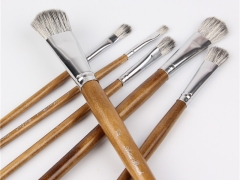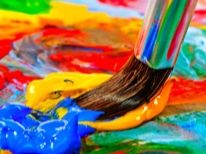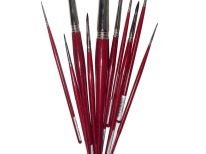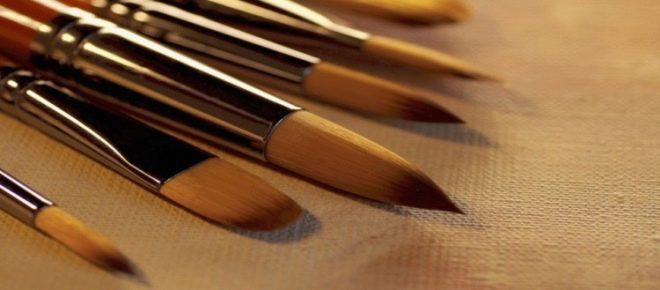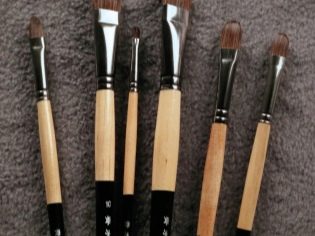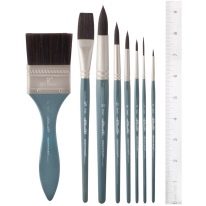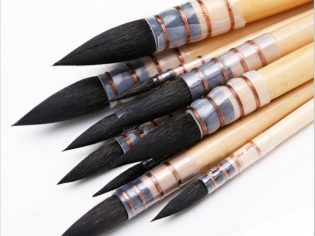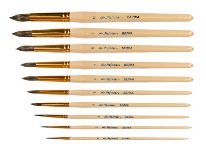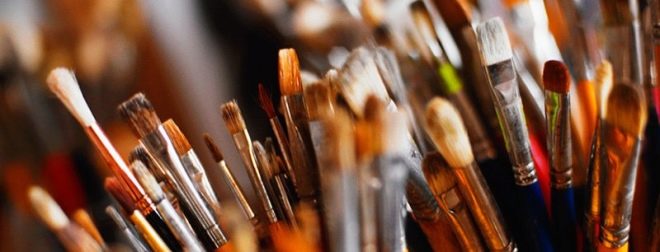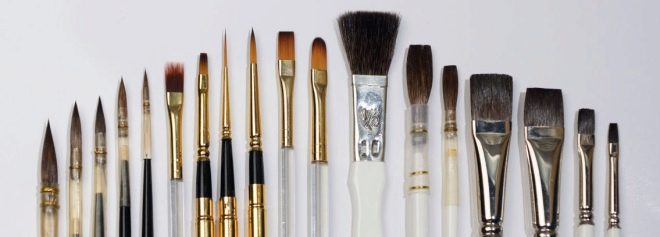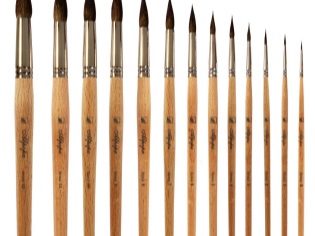Brushes from squirrel fur: how to choose?
Each student in the box can be found squirrel brush. Its quality and material properties have many advantages for drawing. Therefore, it becomes the most selectable and often the first in the arsenal of young and professional artists.
Material Features
This brush is familiar to many. It can be recognized not only by the inscription “squirrel” on the handle, but also by its soft texture. Like all brushes, it consists of a pile, a wooden handle and a galvanized braid that clamps the fur.
These accessories are suitable for painting with any paint, but best of all they work with watercolor and gouache. Oil paints are not suitable for her - the hairs start to crawl out of their aggressive composition, and the softness does not allow making high-quality strokes. Soft squirrel brushes leave a dense and rich trace of paint, making the process of drawing pleasant and easy. They absorb well and give up water.
This pile is made of this brush from the fur of the tail of the Siberian squirrel, usually of black or red color. The shape is conical, and the hair texture is thin, soft and elastic - the hairs do not break. Because of this, it is easy to type paint. However, these same properties contribute to the rapid abrasion of the pile.
This soft material perfectly copes with images on paper, textiles, clay, porcelain, ceramic and faience products.
Moreover, squirrel fur is used in brushes for cosmetology, since It is mild and hypoallergenic. Caring for such tools is simple. They need only be washed with water. Tassels can be safely left in the water, as this will not affect the quality and will not spoil the product.
Types
Most often the squirrel brush has a round shape, as it is intended for thick strokes, and when working with it, the hairs do not diverge, do not leave strips. Round brushes are widespread. There are no problems with their acquisition. Such variants are used for drawing with watercolor and for drawing small elements.
Oval brushes are similar to them. They are used to draw details. If the picture is small, then you can do with round tools.
There is another type - flat, which are much less common. They are chosen by artists. They are comfortable with precise application and clear lines. Used in the application of gouache, tempera and acrylic. Temper is pre-diluted for a more supple consistency.
Less known, but used by professional types:
- brushes for wide brush strokes;
- font for thin lines (for graphics);
- fan to soften the contours;
- lammsel for gilding or gold leaf.
Flat and professional brushes are more expensive than round ones.
Dimensions
The size of the brush is indicated on the handle. For rounds, the number indicates the width of the tassel in millimeters, that is, No. 5 corresponds to a diameter of 5 mm. The number on a flat brush denotes its width.
From this figure depends on the thickness of the hairs, that is, their number:
- numbers 2, 3, 4 are suitable for painstaking and fine work;
- thicker brushes suitable for schoolchildren - 6, 8, 9;
- sizes 10, 12, 18, 20 are suitable for artists with broad strokes and large canvases.
A large brush is convenient for a solid pattern. Artists prefer brushes with a long handle, as they provide the convenience of brush strokes, cleanliness and excellent vision of the painting as a whole. She usually draws on easels.
However, each manufacturer has different size markings; moreover, one manufacturer may have different sizes in different batches - No. 9 from one and No. 12 from another series may be exactly the same.
How to choose?
When it comes to choosing a brush, it is important to consider many aspects:
- handle material and size;
- hair length;
- brush size.
The handle should be smooth. Most often, manufacturers offer plastic and wood. The plastic may slip, but will not cause damage. With a wooden handle, you can put a splinter, and children can gnaw it, which has consequences more dangerous than a pricked finger. Children prefer plastic - safe and durable.
As for the length, then you need to pick up on convenience while in the hand. Short tassels are suitable for children, and long brushes - for professionals.
The clamping base should hold the hairs tightly and also fit snugly to the handle. Sticking to the side of the hairs are unacceptable - the brush will scatter after a couple of uses, and will also leave an unpleasant pattern. Best of all is a solid base, without seams. It will be convenient to work with him, hold the brush in his hand, plus a curious baby will not be able to pick it up. However, some use a base seam to repair the brush.
No less important are the hairs in the tassel. They should hold tight in the base. Inadmissible falling hairs. This can be checked with a slight twitch. The villi should have the same length and elasticity. The longer the hair, the wider the band, and the harder it is to create straight lines and contour patterns. Also, there should be no foreign fibers that can ruin the drawing process. Pay attention to the glue that holds these parts together - it should not be visible.
Art brushes are sold in a set. In this case, you should pay attention to each brush, take into account the size. Drawing sets also have numbered paintings with appropriate brushes and paint types - for watercolor, gouache or acrylic. However, it is not always the number sets have brushes - then you have to try to find the right size yourself. Ready kits suitable for novice artists. They will help develop a sense of taste, technique, accuracy, and simply understand whether this is your hobby.
Squirrel brushes, of course, one of the most popular and versatile tools for drawing. They are suitable for beginners to draw babies who find it difficult to cope with the first strokes, and for professionals dealing with large canvases.
Thanks to the right tool, the attitude to the working process also changes - I want to try and enjoy working.
See how to wash your brushes in the next video.
